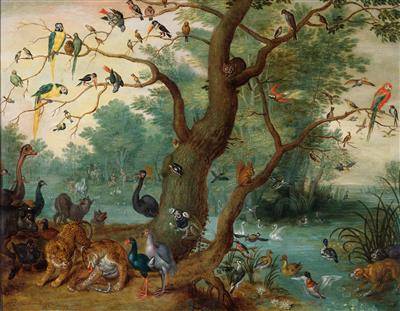Jan Brueghel II.

(Antwerp 1601–1678)
Paradisical landscape
oil on copper, 23.8 x 30.5 cm, framed
We are grateful to Klaus Ertz for confirming the attribution after examination of the present painting in the original (written communication).
Ertz writes: “The paints, standing out in relief so that one can feel them with one’s fingertips, give a bright and brilliant impression. They have been applied in a thick impasto and seem typical of the artist’s early period, shortly after Jan Brueghel the Younger had returned from Italy and taken over his father’s studio […]. The subject of ‘paradisical landscapes’ was not only treated by the son, but also by the father, Jan Brueghel the Elder, who had revisited the theme time and again in a wide spectrum of variations from the 1590s until well into the second decade of the 17th century. The motif of the paradisical landscape played an important role in the son’s career from the very beginning. He often studied his father’s examples and modified them, creating something new on the basis of the formal canon of his model. Due to the numerous animals, which are highly characteristic of these pictures and account for their being described as ‘paradisical’ landscapes, the theme turned into a genre in its own right. Until well into the 1630s, these landscapes were the focus of the pictorial message. Paradisical landscapes were obviously highly popular at the time and in great demand among collectors. Otherwise it would be difficult to explain why there exist so many variations of this theme by the hands of so many different artists. At the same time, the ‘Tree of Birds’, an original and independent interpretation that actually belongs to the Allegories of the Senses, must be regarded as an ‘Allegory of Hearing’ when seen isolated from the ‘Fall of Man’. It can therefore be said that in the painting to be assessed, Jan Brueghel the Younger has combined two independent pictorial subjects – a paradisical landscape and an allegory.”
Ertz dates the present painting into the second half of the 1620s and compares it to paintings by Jan Brueghel II dating from around the same period:
1. The Concert of Birds (Herzog-Anton-Ulrich-Museum, Braunschweig);
2. Macaws, Toucans and Songbirds on a Tree (Leggatt Brothers, London, 1963);
3. Paradisical Landscape with the Fall of Man (Szépmüveszéti Museum, Budapest);
4. Paradisical Landscape with the Fall of Man (Museo del Prado, Madrid)
Specialist: Dr. Alexander Strasoldo
 Dr. Alexander Strasoldo
Dr. Alexander Strasoldo
+43-1-515 60-556
alexander.strasoldo@dorotheum.at
20.10.2015 - 18:00
- Realized price: **
-
EUR 132,924.-
- Estimate:
-
EUR 100,000.- to EUR 150,000.-
Jan Brueghel II.
(Antwerp 1601–1678)
Paradisical landscape
oil on copper, 23.8 x 30.5 cm, framed
We are grateful to Klaus Ertz for confirming the attribution after examination of the present painting in the original (written communication).
Ertz writes: “The paints, standing out in relief so that one can feel them with one’s fingertips, give a bright and brilliant impression. They have been applied in a thick impasto and seem typical of the artist’s early period, shortly after Jan Brueghel the Younger had returned from Italy and taken over his father’s studio […]. The subject of ‘paradisical landscapes’ was not only treated by the son, but also by the father, Jan Brueghel the Elder, who had revisited the theme time and again in a wide spectrum of variations from the 1590s until well into the second decade of the 17th century. The motif of the paradisical landscape played an important role in the son’s career from the very beginning. He often studied his father’s examples and modified them, creating something new on the basis of the formal canon of his model. Due to the numerous animals, which are highly characteristic of these pictures and account for their being described as ‘paradisical’ landscapes, the theme turned into a genre in its own right. Until well into the 1630s, these landscapes were the focus of the pictorial message. Paradisical landscapes were obviously highly popular at the time and in great demand among collectors. Otherwise it would be difficult to explain why there exist so many variations of this theme by the hands of so many different artists. At the same time, the ‘Tree of Birds’, an original and independent interpretation that actually belongs to the Allegories of the Senses, must be regarded as an ‘Allegory of Hearing’ when seen isolated from the ‘Fall of Man’. It can therefore be said that in the painting to be assessed, Jan Brueghel the Younger has combined two independent pictorial subjects – a paradisical landscape and an allegory.”
Ertz dates the present painting into the second half of the 1620s and compares it to paintings by Jan Brueghel II dating from around the same period:
1. The Concert of Birds (Herzog-Anton-Ulrich-Museum, Braunschweig);
2. Macaws, Toucans and Songbirds on a Tree (Leggatt Brothers, London, 1963);
3. Paradisical Landscape with the Fall of Man (Szépmüveszéti Museum, Budapest);
4. Paradisical Landscape with the Fall of Man (Museo del Prado, Madrid)
Specialist: Dr. Alexander Strasoldo
 Dr. Alexander Strasoldo
Dr. Alexander Strasoldo
+43-1-515 60-556
alexander.strasoldo@dorotheum.at
|
Buyers hotline
Mon.-Fri.: 10.00am - 5.00pm
old.masters@dorotheum.at +43 1 515 60 403 |
| Auction: | Old Master Paintings |
| Auction type: | Saleroom auction |
| Date: | 20.10.2015 - 18:00 |
| Location: | Vienna | Palais Dorotheum |
| Exhibition: | 10.10. - 20.10.2015 |
** Purchase price incl. charges and taxes(Country of delivery: Austria)
It is not possible to turn in online buying orders anymore. The auction is in preparation or has been executed already.
More objects by this artist
-

Estimate:
EUR 40,000.- to EUR 60,000.- -

Jan Brueghel II and Pieter van Avont
Estimate:
EUR 30,000.- to EUR 50,000.- -

Workshop of Jan Brueghel II and Workshop of Hendrick van Balen I
Estimate:
EUR 12,000.- to EUR 18,000.-
